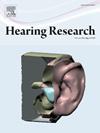Coupling-induced tunability of characteristic frequency, bandwidth and gain of artificial hair cells
IF 2.5
2区 医学
Q1 AUDIOLOGY & SPEECH-LANGUAGE PATHOLOGY
引用次数: 0
Abstract
Drawing inspiration from nature, we develop bio-inspired acoustic sensors with integrated signal processing capabilities to (i) close the performance gap between the human hearing and machine hearing and (ii) test models on biological hearing. Particularly important is thereby the combination of frequency decomposition with nonlinear (compressive) amplification of the sound signals. Here, the question arises, how the frequency resolution of 0.1–0.4%, the large gain and the coverage of the large frequency range of 20 Hz to 20 kHz can be obtained with a modest number of 3000 inner hair cells as transducers without missing tones. To solve this issue, it was hypothesized that the cochlea can be modeled as coupled critical oscillators. We study experimentally and theoretically the effects of coupling critical oscillators using bio-inspired acoustic sensors, which are based-on microelectromechanical system (MEMS) resonators with a high-quality factor and a resonance frequency set by the geometry. Using electronic feedback, these resonators act like critical oscillators tuned near Andronov–Hopf bifurcation point. If output-signal coupling is added, three different bifurcation points are generated. Tuning the system close to one of these bifurcation points leads to a highly tunable behavior and sound pressure dependent sensitivity that is compressive in nature. In this case, the response frequency of the sensor system can be shifted by tuning the control parameter for bifurcation, allowing to cover larger bandwidths with one sensor pair while retaining high quality factors. Furthermore, tuning coupling and feedback strength, bandwidth and gain of each sensor can be adapted as needed. Using these effects, an adaptive filter bank to model the cochlear functionality and adaptation can be build. Since efferent feedback can tune the response of outer hair cells and thus inner hair cells and basilar membrane as well, the question arises if such tuning mechanisms can be observed in the mammalian cochlea as well.
人造毛细胞特征频率、带宽和增益的耦合可调性
从大自然中汲取灵感,我们开发了具有集成信号处理能力的仿生声学传感器,以(i)缩小人类听力和机器听力之间的性能差距,(ii)测试生物听力模型。因此,特别重要的是将频率分解与声音信号的非线性(压缩)放大相结合。在这里,问题出现了,如何获得0.1-0.4%的频率分辨率,大增益和覆盖20hz至20khz的大频率范围,用3000个内部毛细胞作为换能器而不丢失音调。为了解决这个问题,我们假设耳蜗可以被建模为耦合临界振荡器。本文从实验和理论两方面研究了基于微机电系统(MEMS)谐振器的仿生声传感器对耦合临界振荡器的影响,该传感器具有高质量的因数和由几何形状设置的谐振频率。利用电子反馈,这些谐振器就像在Andronov-Hopf分岔点附近调谐的临界振荡器一样。如果加入输出信号耦合,则会生成三个不同的分岔点。将系统调整到接近这些分岔点之一的位置,可以获得高度可调的行为和声压依赖灵敏度,本质上是压缩的。在这种情况下,可以通过调整分岔的控制参数来改变传感器系统的响应频率,从而允许用一个传感器对覆盖更大的带宽,同时保持高质量因子。此外,每个传感器的调谐耦合和反馈强度、带宽和增益可以根据需要进行调整。利用这些效应,可以建立一个自适应滤波器组来模拟耳蜗的功能和适应性。既然传出反馈可以调节外毛细胞的反应,因此也可以调节内毛细胞和基底膜的反应,那么问题来了,这种调节机制是否也可以在哺乳动物耳蜗中观察到。
本文章由计算机程序翻译,如有差异,请以英文原文为准。
求助全文
约1分钟内获得全文
求助全文
来源期刊

Hearing Research
医学-耳鼻喉科学
CiteScore
5.30
自引率
14.30%
发文量
163
审稿时长
75 days
期刊介绍:
The aim of the journal is to provide a forum for papers concerned with basic peripheral and central auditory mechanisms. Emphasis is on experimental and clinical studies, but theoretical and methodological papers will also be considered. The journal publishes original research papers, review and mini- review articles, rapid communications, method/protocol and perspective articles.
Papers submitted should deal with auditory anatomy, physiology, psychophysics, imaging, modeling and behavioural studies in animals and humans, as well as hearing aids and cochlear implants. Papers dealing with the vestibular system are also considered for publication. Papers on comparative aspects of hearing and on effects of drugs and environmental contaminants on hearing function will also be considered. Clinical papers will be accepted when they contribute to the understanding of normal and pathological hearing functions.
 求助内容:
求助内容: 应助结果提醒方式:
应助结果提醒方式:


